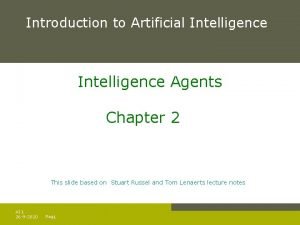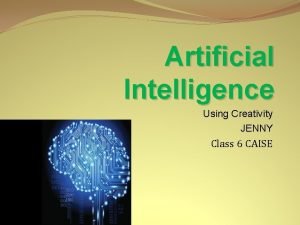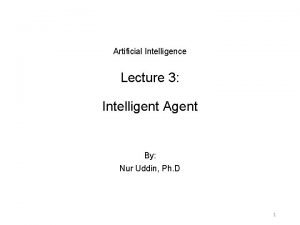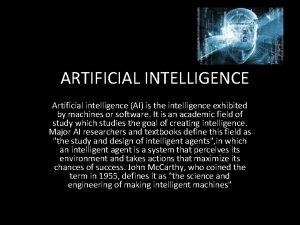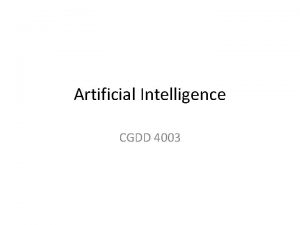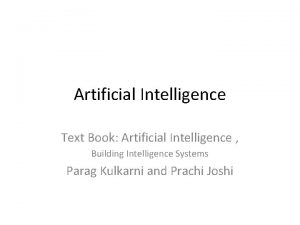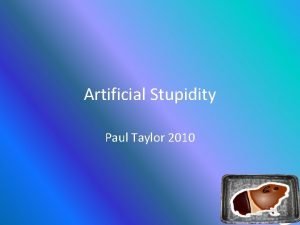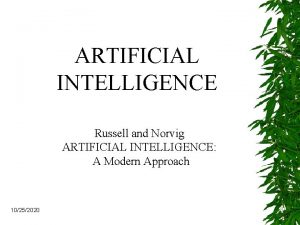PRESENTATION Artificial Intelligence Knowledge Types of knowledge in
























- Slides: 24

PRESENTATION (Artificial Intelligence) Knowledge Types of knowledge in AI Issues of Knowledge Representation

Knowledge � Knowledge is a familiarity, awareness or understanding of someone or something, such as facts, information, descriptions, or skills, which is acquired through experience or education by perceiving, discovering, or learning

Continue… � Knowledge is the body of facts and principles. Knowledge can be language, concepts, procedures, rules, ideas, abstractions, places, customs, and so on. study of knowledge is called Epistemology.

Types of Knowledge in AI There are 5 main types of knowledge representation in Artificial Intelligence. v Meta Knowledge v Heuristic - Knowledge v Procedural Knowledge v Declarative Knowledge v Structural Knowledge

Meta Knowledge � � Its a knowledge about a knowledge and how to gain them. Meta-knowledge includes information about the knowledge the system possesses, about the efficiency of certain methods used by the system, the probabilities of the success of past plans, etc. The meta-knowledge is generally used to guide future planning or execution phases of a system.

Heuristic Knowledge v v Heuristic refers to experience-based techniques for problem solving, learning, and discovery that give a solution which is not guaranteed to be optimal. Where the exhaustive search is impractical, heuristic methods are used to speed up the process of finding a satisfactory solution via mental shortcuts to ease the cognitive load of making a decision.

example � Examples of this method include using a rule of thumb, an educated guess, an intuitive judgment, stereotyping, or common sense

Procedural knowledge � � � In artificial intelligence, procedural knowledge is compiled or processed form of information. Procedural knowledge is related to the performance of some task. For example, sequence of steps to solve a problem is procedural knowledge. A well-known example is the Procedural Reasoning System, which might, in the case of a mobile robot that navigates in a building, contain procedures such as "navigate to a room" or "plan a path"

Declarative knowledge � Declarative knowledge is passive knowledge in the form of statements of facts about the world. For example, mark statement of a student is declarative knowledge.

Structural knowledge � � � Structural knowledge is built with schemas and interrelated schemas (schemata). through schema selection or inheritance of attributes from other schemas in order to acquire structural knowledge. Describes what relationship exists between concepts/ objects.

Knowledge representation � � AI agents deal with knowledge (data) Facts (believe & observe knowledge) Procedures (how to knowledge) Meaning (relate & define knowledge)

Continue. . � Any intelligent entity that wishes to reason about its world encounters an important, inescapable fact: reasoning is a process that goes on internally, while most things it wishes to reason about exist only externally.

Continue. . � A program (or person) engaged in planning the assembly of a bicycle, for instance, may have to reason about entities like wheels, chains, sprockets, handle bars, etc. , yet such things exist only in the external world.

Issues in Knowledge Representation � � � Knowledge level debugging Infinite loops Querying the user

Continue. . � � Just as in other software, there can be errors and omissions in knowledge bases. Domain experts and knowledge engineers must be able to debug a knowledge base and add knowledge.

Continue. . � In knowledge-based systems, debugging is difficult because the domain experts and users who have the domain knowledge required to detect a bug do not necessarily know anything about the internal working of the system, nor do they want to.

Example. . � � For example, debugging a medical knowledge base should be a question of medicine that medical experts, who are not experts in AI, can answer. Similarly, debugging a knowledge base about house wiring should be with reference to the particular house, not about the internals of the system reasoning with the knowledge base.

Infinite loops � There is an infinite loop in the top-down derivation if there is an atom a that is being proved as a subgoal of a. (Here we assume that being a subgoal is transitive; a subgoal of a subgoal is a subgoal).

Continue. . � Thus, there can be an infinite loop only if the knowledge base is cyclic. A knowledge base is cyclic if there is an atom a such that there is a sequence of definite clauses of the form

Continue. . � � � a ←. . . a 1 ←. . . a 2. . . an ←. . . a. . . (where if n=0 there is a single definite clause with a in the head and body).

Querying the user � At design time or offline, there is typically no information about particular cases. This information arrives online from users, sensors, and external knowledge sources.

For example � For example, a medical-diagnosis program may have knowledge represented as definite clauses about the possible diseases and symptoms but it would not have knowledge about the actual symptoms manifested by a particular patient

Continue. . � he idea of querying the user is that the system can treat the user as a source of information and ask the user specific questions about a particular case. The proof procedure can determine what information is relevant and will help to prove a query.

THANKYOU
 What is declarative knowledge in ai
What is declarative knowledge in ai Knowledge manipulation in artificial intelligence
Knowledge manipulation in artificial intelligence Artificial probing chapter 2
Artificial probing chapter 2 Mycin advantages and disadvantages
Mycin advantages and disadvantages State space search in ai
State space search in ai Searching for solutions in artificial intelligence
Searching for solutions in artificial intelligence 15-780 graduate artificial intelligence
15-780 graduate artificial intelligence Starts new page numbered sequentially
Starts new page numbered sequentially Kecerdasan kepemimpinan
Kecerdasan kepemimpinan Artificial intelligence assessment
Artificial intelligence assessment Math and artificial intelligence
Math and artificial intelligence Examples of peas
Examples of peas 15-780 graduate artificial intelligence
15-780 graduate artificial intelligence Xkcd image recognition
Xkcd image recognition The number of fuzzy propositions are
The number of fuzzy propositions are Cse 471 asu
Cse 471 asu 15-780 graduate artificial intelligence
15-780 graduate artificial intelligence Informed search and uninformed search
Informed search and uninformed search What is artificial intelligence class 6
What is artificial intelligence class 6 Levels of language analysis
Levels of language analysis Omniscience in artificial intelligence
Omniscience in artificial intelligence Int404
Int404 Solving problems by searching artificial intelligence
Solving problems by searching artificial intelligence Partitioned semantic nets in artificial intelligence
Partitioned semantic nets in artificial intelligence A* vs ao*
A* vs ao*


